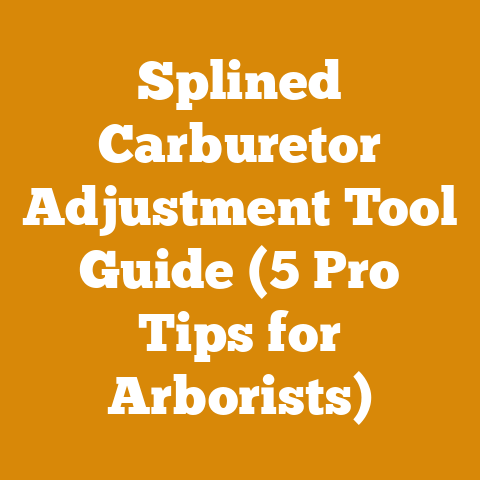Stihl 011 AVT Chainsaw Maintenance Tips (5 Pro Repairs)
WARNING! Chainsaws are inherently dangerous tools. Improper use can lead to serious injury or even death. Always wear appropriate safety gear, including eye protection, hearing protection, gloves, and sturdy footwear. Read and understand the chainsaw’s operating manual before use, and never operate a chainsaw if you are fatigued or under the influence of drugs or alcohol. These maintenance tips are for informational purposes only and should not replace professional service or repair. If you are not comfortable performing these tasks, consult a qualified chainsaw technician.
Stihl 011 AVT Chainsaw Maintenance Tips (5 Pro Repairs)
The Stihl 011 AVT. Even just hearing those letters brings back a flood of memories. My grandfather, a seasoned logger in the Pacific Northwest, swore by his. It wasn’t the newest, flashiest saw, but it was a workhorse. Reliable, dependable, and, with a little TLC, kept going strong. I inherited that saw, and while it’s not my primary tool anymore, I still fire it up from time to time. It’s a reminder of the grit and skill it takes to work with wood. And like any finely tuned machine, the Stihl 011 AVT needs regular maintenance to keep it humming.
Over the years, I’ve learned a few tricks and techniques specific to this model. These aren’t just theoretical concepts; these are hard-earned lessons from the field, from troubleshooting breakdowns in the middle of nowhere to optimising performance for specific wood types. I’m sharing five pro-level repairs, or rather maintenance tasks, that can keep your Stihl 011 AVT running like a champ.
1. Carburetor Cleaning and Adjustment: The Heart of the Matter
The carburetor is the heart of any two-stroke engine, and the Stihl 011 AVT is no exception. A dirty or poorly adjusted carburetor can lead to a whole host of problems, from hard starting to poor performance and even engine damage.
Why it Matters: A clean and properly adjusted carburetor ensures the correct air-fuel mixture for optimal combustion. This translates to better fuel efficiency, more power, and reduced emissions.
My Experience: I remember one particularly frustrating day when my 011 AVT refused to start. After checking the spark plug and fuel lines, I finally realized the carburetor was clogged with old fuel residue. A thorough cleaning and adjustment got it purring like a kitten again.
The Process:
- Safety First: Disconnect the spark plug wire before working on the carburetor.
- Access: Remove the air filter cover and air filter. You’ll now have access to the carburetor.
- Disassembly: Carefully disconnect the fuel lines from the carburetor. Note their positions for reassembly. Remove the carburetor from the engine.
- Cleaning: Disassemble the carburetor. Use carburetor cleaner to thoroughly clean all parts, including the jets, needle valve, and float bowl. Compressed air can be helpful for clearing out small passages.
- Reassembly: Reassemble the carburetor, ensuring all parts are properly seated.
- Installation: Reinstall the carburetor onto the engine, reconnecting the fuel lines.
-
Adjustment: This is where it gets a bit tricky. The Stihl 011 AVT typically has three adjustment screws:
- L (Low-speed): Adjusts the fuel mixture at idle.
- H (High-speed): Adjusts the fuel mixture at full throttle.
- LA (Idle Speed): Adjusts the engine’s idle speed.
Initial Settings: As a starting point, turn both the L and H screws clockwise until they are lightly seated. Then, back them out 1 to 1 1/2 turns.
Fine-Tuning:
- Starting: Start the engine. If it doesn’t start easily, adjust the L screw slightly until it starts and idles smoothly.
- Idle Speed: Adjust the LA screw until the chain stops moving at idle. If the engine stalls, increase the idle speed slightly.
- High-Speed: This is best done with a tachometer. The Stihl 011 AVT’s maximum RPM should be around 12,500. Adjust the H screw until the engine reaches this RPM at full throttle. Important: Avoid running the engine lean (too much air, not enough fuel) at full throttle, as this can cause serious damage. If you don’t have a tachometer, listen to the engine. It should sound smooth and powerful at full throttle. If it sounds raspy or strained, it’s likely too lean. Back out the H screw slightly to richen the mixture.
- Final Check: After adjusting the carburetor, let the engine run for a few minutes to ensure it’s running smoothly. Check for any signs of overheating or unusual noises.
Data Points and Statistics:
- Air-Fuel Ratio: The ideal air-fuel ratio for a two-stroke engine like the Stihl 011 AVT is around 14.7:1. However, this can vary depending on the specific engine and operating conditions.
- RPM: The maximum RPM of the Stihl 011 AVT is approximately 12,500. Running the engine above this RPM can cause damage.
- Carburetor Cleaner: Use a high-quality carburetor cleaner specifically designed for two-stroke engines. Avoid using harsh chemicals that can damage the carburetor’s delicate parts.
Technical Requirements:
- Tools: Screwdrivers (flathead and Phillips), carburetor cleaner, compressed air (optional), tachometer (optional).
- Materials: Carburetor rebuild kit (optional, but recommended if the carburetor is very dirty or worn).
Practical Tips:
- Fuel Stabilizer: Always use a fuel stabilizer in your gasoline to prevent fuel from going bad and clogging the carburetor.
- Regular Cleaning: Clean the carburetor at least once a year, or more often if you use your chainsaw frequently.
- Professional Help: If you’re not comfortable adjusting the carburetor yourself, take it to a qualified chainsaw technician.
2. Ignition System Inspection and Spark Plug Replacement: Keeping the Fire Alive
A faulty ignition system can prevent your chainsaw from starting or cause it to run poorly. The spark plug is a critical component of the ignition system, and it should be inspected and replaced regularly.
Why it Matters: The spark plug provides the spark that ignites the air-fuel mixture in the cylinder. A worn or fouled spark plug can result in a weak spark, leading to misfires and reduced power.
My Experience: I had a situation where my 011 AVT would start, but it would run rough and stall frequently. I initially suspected the carburetor, but after cleaning it, the problem persisted. It turned out the spark plug was heavily fouled with carbon deposits. Replacing it solved the issue instantly.
The Process:
- Safety First: Disconnect the spark plug wire.
- Access: Locate the spark plug. It’s usually located on the top of the engine, near the cylinder head.
- Removal: Use a spark plug wrench to remove the spark plug.
-
Inspection: Inspect the spark plug. Look for signs of wear, damage, or fouling. The electrode should be clean and sharp, and the insulator should be free of cracks or chips.
Spark Plug Condition Guide:
- Normal: Light tan or gray deposits. This indicates the engine is running properly.
- Fouled: Black, oily deposits. This indicates the engine is running too rich (too much fuel).
- Worn: Rounded electrode. This indicates the spark plug is old and needs to be replaced.
- Damaged: Cracked or chipped insulator. This indicates the spark plug is damaged and needs to be replaced.
- Replacement: If the spark plug is worn, damaged, or fouled, replace it with a new one. Use the correct spark plug for your Stihl 011 AVT. The recommended spark plug is typically a Bosch WSR6F or NGK BPMR7A.
- Gap Adjustment: Before installing the new spark plug, check the gap. The gap is the distance between the electrode and the ground electrode. The correct gap for the Stihl 011 AVT is typically 0.5 mm (0.020 inches). Use a spark plug gap tool to adjust the gap if necessary.
- Installation: Install the new spark plug, tightening it to the manufacturer’s recommended torque. This is usually around 15-20 Nm (11-15 ft-lbs).
- Reconnection: Reconnect the spark plug wire.
Data Points and Statistics:
- Spark Plug Gap: The correct spark plug gap for the Stihl 011 AVT is 0.5 mm (0.020 inches).
- Spark Plug Torque: The recommended torque for tightening the spark plug is 15-20 Nm (11-15 ft-lbs).
- Spark Plug Replacement Interval: Replace the spark plug every 100 hours of use, or more often if you notice any signs of wear or fouling.
Technical Requirements:
- Tools: Spark plug wrench, spark plug gap tool, torque wrench (optional).
- Materials: New spark plug (Bosch WSR6F or NGK BPMR7A).
Practical Tips:
- Carry a Spare: Always carry a spare spark plug with you when you’re working in the field.
- Proper Storage: Store spark plugs in a clean, dry place to prevent corrosion.
- Check the Ignition Coil: If you’re still having ignition problems after replacing the spark plug, the ignition coil may be faulty. This is a more complex repair that may require professional assistance.
3. Chain Sharpening and Maintenance: The Cutting Edge
A sharp chain is essential for safe and efficient chainsaw operation. A dull chain requires more effort to cut, increases the risk of kickback, and can damage the engine.
Why it Matters: A sharp chain cuts quickly and cleanly, reducing the strain on the engine and the operator. It also improves safety by reducing the risk of kickback.
My Experience: I’ve seen firsthand the difference a sharp chain makes. One time, I was cutting through a large oak log with a dull chain. It was slow, laborious, and the saw was constantly bogging down. After sharpening the chain, the saw sliced through the log like butter. The difference was night and day.
The Process:
- Safety First: Wear gloves and eye protection when sharpening the chain.
- Secure the Chain: Secure the chainsaw in a vise or clamp to prevent it from moving while you’re sharpening.
- Identify the Cutting Angle: Each chain type has a specific cutting angle. Consult your chainsaw’s manual or the chain manufacturer’s specifications to determine the correct angle for your chain. The Stihl 011 AVT typically uses a 30-degree top plate cutting angle and a 60-degree side plate angle.
- Sharpening: Use a round file of the correct size to sharpen the cutting teeth. The file size will depend on the chain’s pitch. For the Stihl 011 AVT, a 4.0 mm (5/32 inch) file is typically used.
- Hold the file at the correct angle and file each tooth from the inside out, using smooth, even strokes.
- Maintain consistent pressure and angle for each tooth.
- File each tooth to the same length.
- Depth Gauge Adjustment: The depth gauges (also known as rakers) control the amount of wood each tooth can cut. After sharpening the teeth, you may need to adjust the depth gauges. Use a depth gauge tool to check the height of the depth gauges. If they are too high, file them down to the correct height. The recommended depth gauge setting for the Stihl 011 AVT is typically 0.65 mm (0.025 inches).
- Chain Tension: Check the chain tension. The chain should be snug on the bar but still able to be pulled around by hand. Adjust the chain tension as needed.
- Lubrication: Lubricate the chain with chain oil.
Data Points and Statistics:
- Cutting Angle: The Stihl 011 AVT typically uses a 30-degree top plate cutting angle and a 60-degree side plate angle.
- File Size: A 4.0 mm (5/32 inch) round file is typically used for sharpening the chain on the Stihl 011 AVT.
- Depth Gauge Setting: The recommended depth gauge setting for the Stihl 011 AVT is typically 0.65 mm (0.025 inches).
Technical Requirements:
- Tools: Round file, depth gauge tool, vise or clamp, chain tensioning tool.
- Materials: Chain oil.
Practical Tips:
- Sharpen Regularly: Sharpen the chain every time you refuel the chainsaw, or more often if you’re cutting dirty or abrasive wood.
- Use a Guide: Use a chain sharpening guide to help you maintain the correct angle and depth.
- Professional Sharpening: If you’re not comfortable sharpening the chain yourself, take it to a professional.
4. Bar Maintenance: Keeping it Straight
The chainsaw bar guides the chain and supports it during cutting. A damaged or worn bar can cause the chain to bind, increase the risk of kickback, and reduce cutting efficiency.
Why it Matters: A well-maintained bar ensures smooth chain movement and proper lubrication, extending the life of the chain and improving cutting performance.
My Experience: I once had a bar that was severely worn and grooved. The chain kept binding, and it was nearly impossible to make a straight cut. Replacing the bar made a huge difference in the saw’s performance.
The Process:
- Inspection: Regularly inspect the bar for signs of wear, damage, or burrs.
- Cleaning: Clean the bar with a wire brush to remove dirt, sawdust, and debris.
- Groove Cleaning: Clean the bar groove with a bar groove cleaner or a small screwdriver.
- Burr Removal: Remove any burrs on the bar rails with a flat file.
- Bar Flipping: Flip the bar over periodically to distribute wear evenly.
- Lubrication Hole Cleaning: Ensure the lubrication holes are clear and unobstructed. Use a small wire to clean them if necessary.
- Bar Straightening: If the bar is bent, you may be able to straighten it using a bar straightening tool. However, if the bar is severely bent, it should be replaced.
- Bar Replacement: Replace the bar if it is severely worn, damaged, or bent.
Data Points and Statistics:
- Bar Length: The Stihl 011 AVT can accommodate bar lengths ranging from 12 inches to 16 inches.
- Bar Rail Wear: The bar rails should be evenly worn. Uneven wear can indicate a problem with the chain or the sprocket.
- Lubrication Hole Size: The lubrication holes should be large enough to allow sufficient oil flow to the chain.
Technical Requirements:
- Tools: Wire brush, bar groove cleaner, flat file, bar straightening tool (optional).
- Materials: Chain oil.
Practical Tips:
- Use the Correct Chain Oil: Use a high-quality chain oil specifically designed for chainsaws.
- Check Oil Level Regularly: Check the chain oil level frequently and refill as needed.
- Store the Chainsaw Properly: Store the chainsaw with the bar covered to protect it from damage.
5. Fuel and Air Filter Maintenance: Breathing Easy
Clean fuel and air filters are essential for proper engine performance. Clogged filters can restrict airflow and fuel flow, leading to reduced power, hard starting, and engine damage.
Why it Matters: Clean filters ensure the engine receives the proper amount of air and fuel for optimal combustion.
My Experience: I once neglected to clean the air filter on my 011 AVT for too long. The engine started running rough, and it was down on power. After cleaning the air filter, the engine ran much better.
The Process:
- Air Filter Removal: Remove the air filter cover and the air filter.
- Air Filter Cleaning: Clean the air filter with compressed air or warm, soapy water. If using compressed air, blow from the inside out. If using water, rinse the filter thoroughly and allow it to dry completely before reinstalling.
- Air Filter Inspection: Inspect the air filter for damage. If the filter is torn or damaged, replace it.
- Fuel Filter Location: The fuel filter is located inside the fuel tank, attached to the end of the fuel line.
- Fuel Filter Removal: Use a hooked wire or a pair of pliers to carefully pull the fuel filter out of the fuel tank.
- Fuel Filter Replacement: Replace the fuel filter with a new one.
- Fuel Tank Cleaning: Periodically clean the fuel tank to remove any sediment or debris.
Data Points and Statistics:
- Air Filter Cleaning Interval: Clean the air filter every 25 hours of use, or more often if you’re working in dusty conditions.
- Fuel Filter Replacement Interval: Replace the fuel filter every 100 hours of use, or more often if you notice any signs of fuel starvation.
- Filter Pore Size: The air filter should have a pore size that is small enough to prevent dust and debris from entering the engine, but large enough to allow sufficient airflow.
Technical Requirements:
- Tools: Compressed air (optional), warm, soapy water, hooked wire or pliers.
- Materials: New air filter, new fuel filter.
Practical Tips:
- Use a Pre-Filter: Use a pre-filter to extend the life of the air filter.
- Store Fuel Properly: Store fuel in a clean, airtight container to prevent contamination.
- Drain Fuel Tank: If you’re not going to use the chainsaw for an extended period of time, drain the fuel tank to prevent fuel from going bad.






